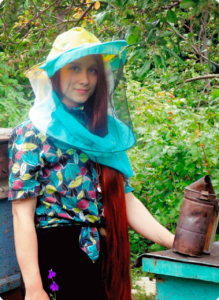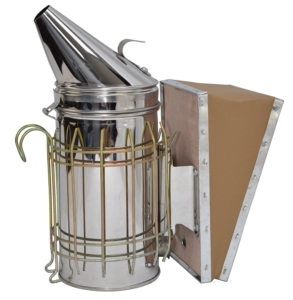
Hi! My name is Veronica.
The main aim of any honey bee colony is survival. The bees collect honey for their winter stores, enabling them to survive until the following spring. As beekeepers, we care for our bees and, in return, take a share of this harvest.
HONEY CROP
When to remove the honey?
Bee-keepers have devised many ways of removing a box of honey-filled frames from the bees. Don’t do this until the honey is ‘ripe’, with a moisture content of around 18% and the cells capped with beeswax. You are looking for 75–100% of the comb surface to be capped over. You can either wait until all the frames in the super have been capped sufficiently, or you can take individual capped frames from different supers and ‘make up’ a super for extraction from several colonies. Shake the bees off each frame as you remove it from its colony and keep the receiving super covered. Remember – don’t leave any gaps in the original supers or the bees will fill them with wild comb. If you don’t have frames of drawn comb, add frames of foundation at the outside edges of the super.
Testing for ripeness
If not all of the cells are capped, hold the frame horizontally over the hive and give it a sharp shake. If nectar flies out of the cells, the honey is not ‘ripe’ and is likely to ferment if you extract it. Put the frame back and wait for the bees to reduce the moisture. If only a few drops shake out, even though the cells may not be capped, the honey in them can be extracted safely.
Clearing supers of bees
Supers can be cleared of bees using a Porter bee escape or a Canadian escape board. These devices are designed as one-way valves, allowing bees to pass from the super to the rest of the hive but not to return.
The Porter bee escape
The Porter escape fits into a hole in a clearer board or inner cover. It has two parts which slide together. The top has a central hole down which the bees pass. The bottom section has two pairs of flexible but reasonably rigid copper or plastic ‘springs’ which are attached to the centers of the edges of the escape, but come together at the other free ends, leaving a gap just less than a bee space. A bee can push through into the rest of the hive, but the gap is too narrow for it to return.
Canadian escape boards
These come in several designs based on the principle that bees can pass one way but are unable to return easily. One that works well is a lozenge-shaped plastic tray, roughly a bee space deep, which is fixed under the clearer board. Bees pass through a hole in the board and are ‘funnelled’ to the openings at the ends. They don’t return to the super unless the clearer board is left on the hive too long when they can work out the way back. Holes in the lozenge allow the colony odor through which attracts bees from the supers. Fix your Canadian escapes with drawing pins so you can remove them easily to clean them.
If they get blocked, they will fail. Place your full super to one side and then replace the other supers to the hive. If you are doing this during the height of the active season, such as after the oilseed rape has finished, add an empty super (with frames of comb or foundation) on top. This gives the bees the room they need. If you cause congestion, you may trigger swarm preparations. Place the clearer board on top of the supers, with the exit hole uppermost. If you put it on upside down, you will get more bees than you know what to do with in the super you are trying to empty. Put the full super on top and add the inner cover and roof. Make sure that all the access points, such as feed holes, are covered.
“If not all of the cells are capped, hold the frame horizontally over the hive and give it a sharp shake. If nectar flies out of the cells, the honey is not ‘ripe’ and is likely to ferment if you extract it”
Good Canadian escape boards can empty a super of bees quite quickly. Put one on in the morning and a super could be bee-free by late afternoon. Twenty-four hours should see 99–100% of the bees out, although there may be a few stragglers. Remove your cleared super and cover it to prevent bees gaining access while you reassemble the hive. Remove the clearer board and replace it with the inner cover as soon as possible. If you leave the clearer board on the hive, the bees will start filling the gaps with wax and propolis, rendering it useless. They are particularly fond of propolising the attached end of the springs in Porter bee escapes, fixing them rigidly in position, disrupting the size of the gap and making them very fiddly to clean out.
Preparing for honey extraction
Honey in the hive is warm because of the general hive temperature and will flow more easily, so don’t leave any cleared supers around to cool down. While you are waiting for the super to clear, prepare your honey extraction area and equipment. Once you have removed the super, take it away to be extracted.
As mentioned earlier, ‘ripe’ honey has a moisture level of around 18% but, because honey is hygroscopic, in prolonged damp weather this may well be higher because the honey has absorbed moisture from the atmosphere. You can measure the moisture content of honey using a refractometer.
Why? Firstly, there is a legal requirement that the moisture level in honey that is sold must be below 20%. Secondly, if the moisture content is too high, the naturally occurring sugar-tolerant yeasts will start off fermentation. This is good if you want to make mead, but not if you want to use or sell your honey. Keep your honey in air-tight containers to prevent it absorbing atmospheric moisture with the associated risk of fermentation.
The end of the honey season
At the end of the honey season, remove any remaining supers from your colonies.
After July, although the weather may be warm and sunny and the bees may be active, there is little forage that cannot be fitted into the brood box. Prolific, Italian-type bees may well need feeding as they have a tendency to use incoming nectar to raise quantities of brood rather than storing it. The sudden reduction in hive volume when you remove the supers may well cause bees to hang outside the hive.
Don’t worry; they will usually sort themselves out and the impulse to swarm will have passed.
Beware robbers
Around this time, reduce colony entrances to a size easier for the colony to defend from robber bees and wasps.
A slot around a bee space high (5–6mm) x 100mm long is suitable, but this depends on the size of the colony and its determination to defend its nest.
Reduce the slot but keep an eye on the hive. If wasps and robber bees are still managing to gain access, make the entrance smaller. You can even take it down to a single bee space wide, if necessary. If returning foragers have to queue to get inside, this is better than the colony losing all its stores to robbers.
The size of wasp colonies is reducing and the sugar reward adults receive when they feed the larvae is dwindling. They are therefore looking for other sources of sweetness. Ripe fruit and jam sandwiches attract them, but so too do honey stores in a beehive. It is essential that your hives are bee-tight, with the only way in and out through the entrance; this gives the colony the best possible chance of repelling unwelcomed visitors.
